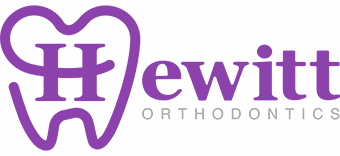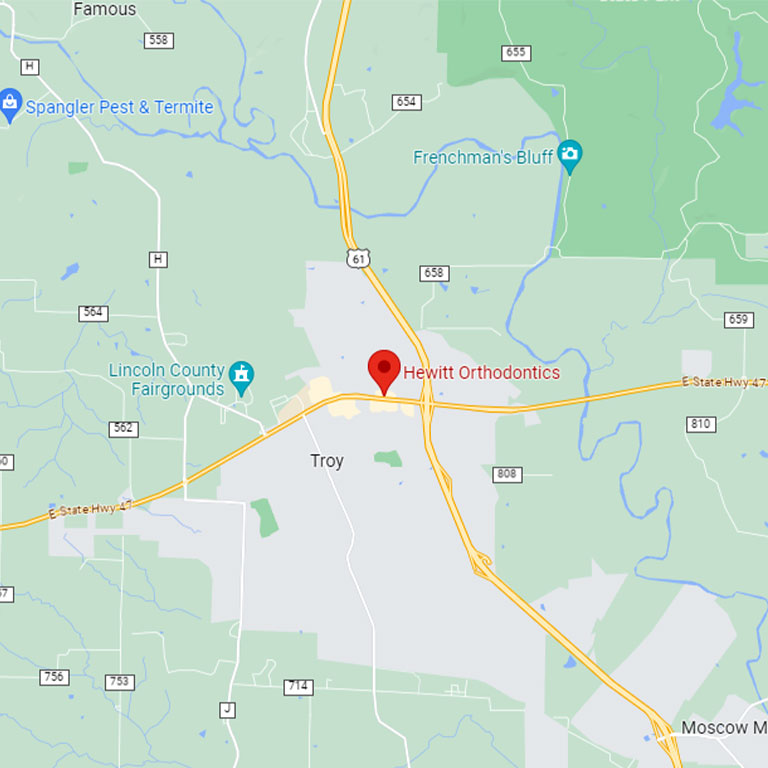Braces 101
What Are Braces?
“Braces” actually consist of three parts:
- A metal bracket, which is affixed directly to the tooth.
- A wire, which is inserted into the bracket and provides the force to move the teeth.
- An “O” tie, which secures the wire to the bracket.
How Do Braces Work?
Braces work by applying gradual, consistent force to the teeth and supporting bone. Over time, this allows the bone to remodel around the tooth as it is repositioned. Through changing the shape, diameter, or dimensions of the wire, the orthodontist is able to control the amount, direction, and duration of pressure to realign the teeth in the most efficient way possible.
How Are Braces Placed?
The process of applying braces is simple! The teeth are prepared with a special process that allows the bracket to temporarily adhere to the enamel surface of the tooth, and a special adhesive holds the bracket in place. The brackets can then be easily removed at the conclusion of treatment. Moisture during this process can cause the brackets to dislodge from the tooth, so the most important thing is to sit very still as the brackets are applied!
When Do I Get My Braces?
Treatment can be beneficial at almost any age! Dental and facial development is unique to each individual; therefore, Dr. Hewitt recommends having a screening to assess you or your child and develop an appropriate treatment timeline. The American Association of Orthodontists (AAO) recommends an initial patient screening at approximately 7 years old. At this age, children have a mixture of both adult and baby teeth, allowing the orthodontist to assess current growth as well as anticipate possible future complications. Understanding that these are children, intervention at this age is as gentle as possible; however, in many cases, intervention is not required. Where treatment is required, the benefits of starting early are immense. Even if a child is over 7 years of age, it is recommended that they are screened as some issues can still be corrected before they progress to more serious problems. If it is determined that your child would not benefit from early intervention treatment, we will monitor growth and development until they are ready for comprehensive treatment.
Do Braces Hurt?
Placing brackets is a completely painless process! Our staff will ensure that you are as comfortable as possible during your appointment; however, it is completely normal to experience some discomfort after leaving our office. Over the counter medication such as acetaminophen and ibuprofen can help alleviate the discomfort associated with the alignment of your teeth. You should not experience any sharp pains, but tenderness with function is also normal. Eating cold foods (such as yogurt) can also help alleviate this sensitivity, as it lessens the activation of the initial wire.
Here are a few tips to effectively care for your teeth and braces:
Brushing – You will be able to brush over top of the braces, similarly to how you care for your teeth without braces. By brushing at a 45º angle above and below the bracket, you can ensure that the entire surface of the tooth remains clean. Be sure to clean both the biting surface and tongue side of your teeth – braces can trap material against your teeth, so it is essential to make a concerted effort to clean every surface thoroughly. Be sure to lightly massage the gums with your toothbrush as well, as this will help keep them clean and healthy.
Electric Toothbrushes – The pulse action of an electric toothbrush can help push out stubborn food or plaque around the brackets. It may be necessary to replace brush heads more often, as the brackets and wire may put additional wear and stress on the bristles. Remember to set a timer and go slow – cleaning thoroughly is essential to keep your mouth healthy with braces.
Flossing – Flossing daily will help remove additional particles or plaque from between your teeth and braces. Utilizing a floss threader or waterpik can be helpful if you’re having difficulty. You may want to practice in the shower – this can get messy!
Choosing the Right Foods – Hard foods like pretzel rods, apples, and hard candy can put stress on wires and damage your braces. Also, chewing gum is not recommended as it can stick to braces or get caught in small pockets of space. It is best to avoid any foods that can put pressure on your brackets or wires. Remember, your brackets are designed to come off at the end of treatment, so be careful!
Regular Check-Ups – In addition to your orthodontic appointments, it is essential to keep up with your regular dental checkups. By visiting your dentist every six months, you can ensure that you have the best smile possible at the end of your treatment!
Troubleshooting
If you are experiencing severe pain or bleeding, call our office ASAP!
Sore Teeth
For the first 3-5 days after your appointment, mild discomfort is expected. This is a result of the new force being applied to your teeth to allow them to move through the surrounding bone. Over the counter pain medication is usually sufficient to manage this discomfort. Mild irritation to the soft tissue, such as lips and cheeks, is also normal. Warm salt water rinses can help keep any inflamed tissue clean and help alleviate sensitivity. Additionally, applying the orthodontic wax received at your visit to braces close to the affected area will help to protect nearby tissue.
Loose Brackets
Having a bracket come loose from the tooth is not usually an emergency situation. Loose brackets can be left in place until you are seen in our office. Applying orthodontic wax to the loose bracket can help protect the tissue in your mouth from any potential complications.
Poking Arch Wires
As the teeth shift, the wires in your brackets will move with them. Occasionally, this can lead to a portion of the wire “poking” the inside of the mouth. Applying wax over the end of the poking wire is usually sufficient to manage this problem; however, if this is not effective, there are a few other things to try. Using heavy fingernail clippers, cuticle cutters, or small wire snips, you can clip the wire behind the bracket and remove that small piece. Additionally, tweezers may be enough to shift the wire back out of the problem position.
Poking Steel Tie
Similarly, a steel tie may lead to a “poking” feeling in your mouth. Using the eraser end of a pencil, you should be able to push the steel tie back in place to alleviate this problem.
Ulcers/Sores in the Mouth
Should any sores develop as a result of contact between appliances and the surrounding soft tissue, apply wax to the braces in this area to protect the inside of your mouth. Over the counter rinses (such as a peroxide rinse) can help with keeping the area clean, and topical oral ointments applied directly to the affected tissue can protect the area and help alleviate pain.
If you are unable to find an answer to your question, or if you have any additional concerns, feel free to contact our office and we will do our best to assist you in finding a solution!

